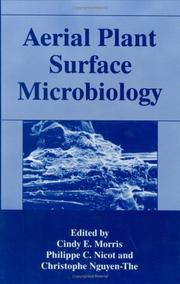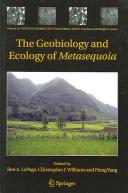| Listing 1 - 10 of 84 | << page >> |
Sort by
|
Book
Year: 2016 Publisher: Singapore : Springer Singapore : Imprint: Springer,
Abstract | Keywords | Export | Availability | Bookmark
 Loading...
Loading...Choose an application
- Reference Manager
- EndNote
- RefWorks (Direct export to RefWorks)
This comprehensive book discusses the ecophysiological features of trees affected by the two most prominent factors of climate change: atmospheric CO2 concentration and temperature. It starts with the introduction of experimental methods at the leaf, branch, the whole-tree, and tree group scales, and in the following chapters elaborates on specific topics including photosynthesis of leaves, respiration of plant organs, water use efficiency, the production of and/or distribution patterns of carbohydrates, secondary metabolites, and nutrients, anatomy of cells and tissues, height and stem-diameter growth, biomass accumulation, leaf phenology and longevity, and model ecosystems (soil-litter-plant enclosures). The current knowledge is neatly summarized, and the author presents valuable data derived from his 30 years of experimental research, some of which is published here for the first time. Using numerous examples the book answers the fundamental questions such as: What are the interactions of elevated CO2 concentration and temperature on tree growth and matter partitioning? How do different tree groups react? Are there any effects on organisms living together with trees? What kinds of models can be used to interpret the results from experiments on trees? This volume is highly recommended for researchers, postdocs, and graduate students in the relevant fields. It is also a valuable resource for undergraduate students, decision-makers in the fields of forest management and environmental protection, and any other scientists who are interested in the effect of global change on ecosystems.
Plant ecology. --- Climate change. --- Plant physiology. --- Trees. --- Plant Ecology. --- Climate Change. --- Plant Physiology. --- Tree Biology.
Book
Year: 2016 Publisher: Singapore : Springer Singapore : Imprint: Springer,
Abstract | Keywords | Export | Availability | Bookmark
 Loading...
Loading...Choose an application
- Reference Manager
- EndNote
- RefWorks (Direct export to RefWorks)
This comprehensive book discusses the ecophysiological features of trees affected by the two most prominent factors of climate change: atmospheric CO2 concentration and temperature. It starts with the introduction of experimental methods at the leaf, branch, the whole-tree, and tree group scales, and in the following chapters elaborates on specific topics including photosynthesis of leaves, respiration of plant organs, water use efficiency, the production of and/or distribution patterns of carbohydrates, secondary metabolites, and nutrients, anatomy of cells and tissues, height and stem-diameter growth, biomass accumulation, leaf phenology and longevity, and model ecosystems (soil-litter-plant enclosures). The current knowledge is neatly summarized, and the author presents valuable data derived from his 30 years of experimental research, some of which is published here for the first time. Using numerous examples the book answers the fundamental questions such as: What are the interactions of elevated CO2 concentration and temperature on tree growth and matter partitioning? How do different tree groups react? Are there any effects on organisms living together with trees? What kinds of models can be used to interpret the results from experiments on trees? This volume is highly recommended for researchers, postdocs, and graduate students in the relevant fields. It is also a valuable resource for undergraduate students, decision-makers in the fields of forest management and environmental protection, and any other scientists who are interested in the effect of global change on ecosystems.
Plant ecology. --- Climate change. --- Plant physiology. --- Trees. --- Plant Ecology. --- Climate Change. --- Plant Physiology. --- Tree Biology.
Book
Year: 2016 Publisher: Singapore : Springer Singapore : Imprint: Springer,
Abstract | Keywords | Export | Availability | Bookmark
 Loading...
Loading...Choose an application
- Reference Manager
- EndNote
- RefWorks (Direct export to RefWorks)
This comprehensive book discusses the ecophysiological features of trees affected by the two most prominent factors of climate change: atmospheric CO2 concentration and temperature. It starts with the introduction of experimental methods at the leaf, branch, the whole-tree, and tree group scales, and in the following chapters elaborates on specific topics including photosynthesis of leaves, respiration of plant organs, water use efficiency, the production of and/or distribution patterns of carbohydrates, secondary metabolites, and nutrients, anatomy of cells and tissues, height and stem-diameter growth, biomass accumulation, leaf phenology and longevity, and model ecosystems (soil-litter-plant enclosures). The current knowledge is neatly summarized, and the author presents valuable data derived from his 30 years of experimental research, some of which is published here for the first time. Using numerous examples the book answers the fundamental questions such as: What are the interactions of elevated CO2 concentration and temperature on tree growth and matter partitioning? How do different tree groups react? Are there any effects on organisms living together with trees? What kinds of models can be used to interpret the results from experiments on trees? This volume is highly recommended for researchers, postdocs, and graduate students in the relevant fields. It is also a valuable resource for undergraduate students, decision-makers in the fields of forest management and environmental protection, and any other scientists who are interested in the effect of global change on ecosystems.
Plant ecology. --- Climate change. --- Plant physiology. --- Trees. --- Plant Ecology. --- Climate Change. --- Plant Physiology. --- Tree Biology.

ISBN: 0585341648 0306453827 Year: 1996 Publisher: New York, New York State : Plenum Press,
Abstract | Keywords | Export | Availability | Bookmark
 Loading...
Loading...Choose an application
- Reference Manager
- EndNote
- RefWorks (Direct export to RefWorks)
''Informative, well-constructed, and readable...The contributors are leaders in their fields and what they have to say is worthwhile.'' --- SGM Quarterly, August 1998.
Plant surfaces --- Plants --- Microbiology --- Ecology. --- Microbiology. --- Botany. --- Morphology (Animals). --- Microbial ecology. --- Trees. --- Medical Microbiology. --- Plant Sciences. --- Animal Anatomy / Morphology / Histology. --- Microbial Ecology. --- Tree Biology. --- Ecology . --- Medical microbiology. --- Plant science. --- Animal anatomy.

ISBN: 0792366360 9048155878 9401596506 Year: 2001 Publisher: Dordrecht : Springer Netherlands : Imprint: Springer,
Abstract | Keywords | Export | Availability | Bookmark
 Loading...
Loading...Choose an application
- Reference Manager
- EndNote
- RefWorks (Direct export to RefWorks)
Conifer Cold Hardiness provides an up-to-date synthesis by leading scientists in the study of the major physiological and environmental factors regulating cold hardiness of conifer tree species. This state-of-the-art reference comprehensively explains current understanding of conifer cold hardiness ranging from the gene to the globe and from the highly applied to the very basic. Topics addressed encompass cold hardiness from the perspectives of ecology, ecophysiology, acclimation and deacclimation, seedling production and reforestation, the impacts of biotic and abiotic factors, and methods for studying and analyzing cold hardiness. The content is relevant to geneticists, ecologists, stress physiologists, environmental and global change scientists, pathologists, advanced nursery and silvicultural practitioners, and graduate students involved in plant biology, plant physiology, horticulture and forestry with an interest in cold hardiness.
Coniferae = Conifers --- cold hardiness --- ecophysiology --- Plant physiology. --- Trees. --- Plant ecology. --- Plant science. --- Botany. --- Plant Physiology. --- Tree Biology. --- Plant Ecology. --- Plant Sciences. --- Botanical science --- Phytobiology --- Phytography --- Phytology --- Plant biology --- Plant science --- Biology --- Natural history --- Plants --- Botany --- Phytoecology --- Vegetation ecology --- Ecology --- Dendrology --- Nursery stock --- Woody plants --- Arboriculture --- Forests and forestry --- Timber --- Physiology --- Floristic botany --- Floristic ecology
Book
ISBN: 3319598198 3319598171 Year: 2017 Publisher: Cham : Springer International Publishing : Imprint: Springer,
Abstract | Keywords | Export | Availability | Bookmark
 Loading...
Loading...Choose an application
- Reference Manager
- EndNote
- RefWorks (Direct export to RefWorks)
This book provides a fresh, updated perspective of the current status and perspectives in genetic improvement of a diverse array of tropical crops. The first part covers aspects which are relevant across crops, namely how to maximize the use of genetic information through modern bioinformatic approaches and how to use statistics as a tool to sustain increased genetic gains and breeding efficiency. The second part of the book provides an updated view of some seed-propagated crops, such as rice, maize and oil palm, as well as crops propagated through vegetative means such as sweet potato, cassava, banana and sugarcane. Each chapter addresses the main breeding objectives, markets served, current breeding approaches, biotechnology, genetic progress observed, and in addition a glimpse into the future for each of these selected and important tropical crops.
Life sciences. --- Trees. --- Plant breeding. --- Life Sciences. --- Plant Breeding/Biotechnology. --- Plant Genetics and Genomics. --- Tree Biology. --- Crop improvement. --- Tropical crops --- Genetics. --- Plantation crops --- Tropical agriculture --- Agriculture --- Crops --- Field crops --- Tropical plants --- Improvement, Crop --- Improvement --- Plant genetics. --- Dendrology --- Nursery stock --- Woody plants --- Arboriculture --- Forests and forestry --- Timber --- Plants --- Genetics --- Breeding
Book
ISBN: 3030184609 3030184595 Year: 2019 Publisher: Cham : Springer International Publishing : Imprint: Springer,
Abstract | Keywords | Export | Availability | Bookmark
 Loading...
Loading...Choose an application
- Reference Manager
- EndNote
- RefWorks (Direct export to RefWorks)
Dothistroma pini changed New Zealand commercial forestry dramatically. Tree breeding became concentrated on a very few species and development of selection methods and breeding strategies changed in response to the new challenges. Tree-Breeding and Genetics in New Zealand provides a critical historical account of the work on provenance research and tree breeding, often with the wisdom of hindsight, and it tracks the development of breeding strategy, especially for P. radiata, Douglas-fir and the most important eucalypt species, E. regnans, E. fastigata and E. nitens. The book is a compendium of abstracts and summaries of all publications and reports on tree improvement in New Zealand since the early 1950s, with added critical comment by the author on much of the work. It is intended for other tree breeders internationally, for interested NZ foresters and for graduate students studying genetics and tree breeding.
Trees --- Breeding --- Genetics. --- Trees. --- Plant breeding. --- Plant genetics. --- Plant Ecology. --- Tree Biology. --- Plant Breeding/Biotechnology. --- Plant Genetics and Genomics. --- Crops --- Agriculture --- Dendrology --- Nursery stock --- Woody plants --- Arboriculture --- Forests and forestry --- Timber --- Botany --- Plants --- Ecology --- Genetics --- Phytoecology --- Vegetation ecology --- Plant ecology. --- Floristic ecology
Book
ISBN: 3030807673 3030807665 Year: 2021 Publisher: Cham : Springer International Publishing AG,
Abstract | Keywords | Export | Availability | Bookmark
 Loading...
Loading...Choose an application
- Reference Manager
- EndNote
- RefWorks (Direct export to RefWorks)
This open access book offers a cross-sectoral reference for both managers and scientists interested in climate-smart forestry, focusing on mountain regions. It provides a comprehensive analysis on forest issues, facilitating the implementation of climate objectives. This book includes structured summaries of each chapter. Funded by the EU’s Horizon 2020 programme, CLIMO has brought together scientists and experts in continental and regional focus assessments through a cross-sectoral approach, facilitating the implementation of climate objectives. CLIMO has provided scientific analysis on issues including criteria and indicators, growth dynamics, management prescriptions, long-term perspectives, monitoring technologies, economic impacts, and governance tools.
Forestry & silviculture: practice & techniques --- Conservation of the environment --- Ecological science, the Biosphere --- Environmental monitoring --- Analytical chemistry --- Environmental economics --- SDG 15 --- Climate-Smart Forestry --- Open Access --- CLIMO --- Forestry Management --- Life on Land --- Tree Biology --- Boscos --- Silvicultura --- Ecologia de les muntanyes --- Clima de muntanya

ISBN: 1280263601 9786610263608 1402027648 1402026315 9400791666 Year: 2005 Publisher: Dordrecht : Springer Netherlands : Imprint: Springer,
Abstract | Keywords | Export | Availability | Bookmark
 Loading...
Loading...Choose an application
- Reference Manager
- EndNote
- RefWorks (Direct export to RefWorks)
The plant fossil record provides evidence that the genus Metasequoia was widely distributed and experienced a wide range of climatic and environmental conditions throughout the Northern Hemisphere from the early Late Cretaceous to the Plio-Pleistocene. Today the genus is limited to one species with approximately 5,000 mature individuals growing in the Xiahoe Valley in southeastern China. This book is a distillation of the collective efforts and results of the world’s Metasequoia specialists and enthusiasts. It is the most up-to-date and comprehensive reference source for the genus and the authors have sought to incorporate obscure, hard-to-get and non-English reference sources. The book reviews what is known about the biology, ecology and physiology of fossil and living Metasequoia, current research directions and problems that remain unresolved. This book presents a definitive overview of fossil and living Metasequoia and was written by sixteen of the world’s experts on this important genus. Given the reality of increasing human pressure and the inevitability of global change, efforts to conserve this ancient genus are underway.
Metasequoia --- Evolution. --- Ecology. --- Redwoods --- Taxodiaceae --- Paleontology . --- Trees. --- Biogeosciences. --- Geoecology/Natural Processes. --- Paleontology. --- Tree Biology. --- Dendrology --- Nursery stock --- Woody plants --- Arboriculture --- Forests and forestry --- Timber --- Fossilogy --- Fossilology --- Palaeontology --- Paleontology, Zoological --- Paleozoology --- Historical geology --- Zoology --- Fossils --- Prehistoric animals in motion pictures --- Balance of nature --- Biology --- Bionomics --- Ecological processes --- Ecological science --- Ecological sciences --- Environment --- Environmental biology --- Oecology --- Environmental sciences --- Population biology --- Ecology --- Geobiology. --- Geoecology. --- Environmental geology. --- Geoecology --- Environmental protection --- Physical geology --- Earth sciences --- Biosphere
Book
ISBN: 3319093819 3319093800 Year: 2014 Publisher: Cham : Springer International Publishing : Imprint: Springer,
Abstract | Keywords | Export | Availability | Bookmark
 Loading...
Loading...Choose an application
- Reference Manager
- EndNote
- RefWorks (Direct export to RefWorks)
This book provides complete, comprehensive and broad subject based reviews complete in it-self, useful for students, teachers, researchers and all others interested in the biodiversity conservation. The field of biotechnology has been kept broad to accommodate the wide ranging topics. How biotechnology can affect and solve the problems related to biodiversity management, protection and conservation are described. Current rates of disappearance of biological and cultural diversity in the world are unprecedented. Intensive resource exploitation due to social and economic factors has led to the destruction, conversion or degradation of ecosystems. Reversing these trends requires time to time assessment to integrate conservation and development. Biotechnological tools, particularly the micropropagation technique has been helpful in developing protocols for multiplication of endangered and threatened species. Chapters are written by leading scientists in their field and include biotechnological approaches to threatened and endangered species, pteridophytes, conifers, non-conifer species of gymnosperms, tree species, impact of genetically modified crops, cryopreservation of diverse species, conservation of forest resources, and health and environment. The book will be useful to botanists, biotechnologists, environmentalists, policy makers, conservationists and NGOs working for environment protection.
Biodiversity. --- Biological diversification --- Biological diversity --- Biotic diversity --- Diversification, Biological --- Diversity, Biological --- Biology --- Biocomplexity --- Ecological heterogeneity --- Numbers of species --- Conservation biology. --- Plant breeding. --- Trees. --- Plant genetics. --- Conservation Biology/Ecology. --- Plant Breeding/Biotechnology. --- Tree Biology. --- Plant Genetics and Genomics. --- Plants --- Genetics --- Dendrology --- Nursery stock --- Woody plants --- Arboriculture --- Forests and forestry --- Timber --- Crops --- Agriculture --- Breeding --- Ecology --- Nature conservation --- Ecology . --- Balance of nature --- Bionomics --- Ecological processes --- Ecological science --- Ecological sciences --- Environment --- Environmental biology --- Oecology --- Environmental sciences --- Population biology
| Listing 1 - 10 of 84 | << page >> |
Sort by
|

 Search
Search Feedback
Feedback About
About Help
Help News
News